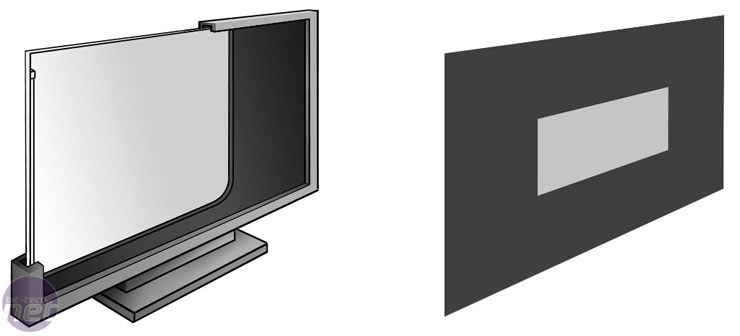Backlighting
While we're on the subject of display limitations, there is one thing that affects your colour fidelity above all things aside from the panel's colour depth. That, my dear friends, is the backlight. CRT lovers, you can largely stop reading now. Since CRTs are lit by phosphorescent compounds, there really is nothing more to be done - the technology has pretty much entirely matured.However, for most of you who are (like me) a lover of the poor TFT-LCD, there are some pretty important considerations when it comes to backlighting. I've hammered home that LCD technology is an additive colour method, and it's time that I fess up. I was lying...sort of.
If it sounds confusing, it's because it marginally is, so I'll do my best to clarify. If you shine a light into a prism, it breaks up into a rainbow, right? Now, if you shine that rainbow back into a prism, it's focused back into white light.
That same theory is at work inside your LCD. Each subpixel has a colour filter that allows only that wavelength of light through - the subpixels do not produce the light themselves, unlike in a CRT. The white backlight shines through the panel, where the colour filter absorbs everything but the proper wavelengths, which it lets pass through to your eye.

This seems like a pretty handy control - by being careful about the colour filter, you can tightly control the light wavelengths that pass through, right? Unfortunately, it's met with two very serious drawbacks. First, you're losing a lot of light in the process, and second (but most important), you can only see what colours the backlight can produce.
Lighting it up
Let's talk about brightness first, as it's the shorter explanation. When you pass light through a polarising filter, you are only accepting light whose wavelength is travelling on the proper axis. Remember, rays are two dimensional but pass through 3D space, meaning that the amplitude (rise and fall) is lined up in a certain direction. Waves that line up properly will go through the filter, but waves that do not are bounced back or absorbed. This means that, to start with, half of the light emitted from the bulb (in traditional LCDs, this is a compact fluorescent array) will never pass the first filter. Of the light that does pass through, only the proper wavelengths will then pass through the colour filter - the rest will be absorbed. So, at best, only one sixth (16.67 percent) of the backlight is passing through the panel.
This means that, to start with, half of the light emitted from the bulb (in traditional LCDs, this is a compact fluorescent array) will never pass the first filter. Of the light that does pass through, only the proper wavelengths will then pass through the colour filter - the rest will be absorbed. So, at best, only one sixth (16.67 percent) of the backlight is passing through the panel. In order to overcome this tremendous dimming effect, LCDs employ very bright backlighting. Of course, this comes with its own downside - see, on cheaper panels, the crystals may not twist completely enough, or the polarising filter may not be high quality. This means that excess "white" light shines through a pixel that is supposed to be black, which is known as "bleeding" light. How much light a display bleeds is measured by the contrast ratio.
To find the contrast ratio, you compare the brightest white a pixel can display (entirely on) to the darkest black a pixel can display (entirely off) while the backlight is on. The higher the contrast ratio, the better an LCD can produce blacks and whites rather than mottled greys. Though higher contrast is generally better, it causes some problems, too - the higher the contrast, the bigger the difference between bits in colour depth.
On an 8-bit display, the increased contrast can be carefully controlled by the crystal, making very smooth transitions between colours. On a 6-bit display, high contrast can make much clearer banding, as the display can't control the crystal as finely. This is usually compensated for by using less overall brightness, making the differences between shades less noticeable.
One final note - it's important to pair your contrast and brightness for your overall viewing. If you game in dimly lit environments, brighter displays with low contrast will show you just how grey black really can be. Conversely, a low-brightness display will leave you scratching your head in a brightly lit environment, wondering about all the black you see. Also, eyes are less sensitive to colour in low-light environments, so higher-quality 8-bit or even 10-bit panels may not make much difference if they're not sufficiently bright. This is also true for TVs, so think carefully about your watching habits!

MSI MPG Velox 100R Chassis Review
October 14 2021 | 15:04









Want to comment? Please log in.